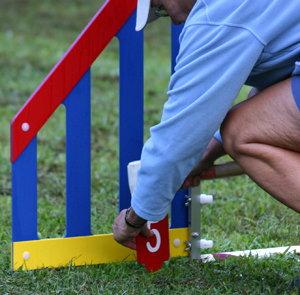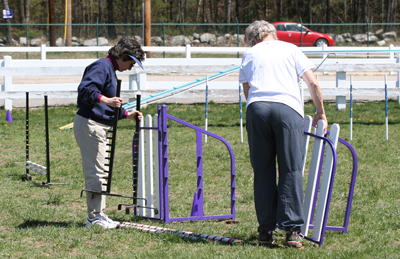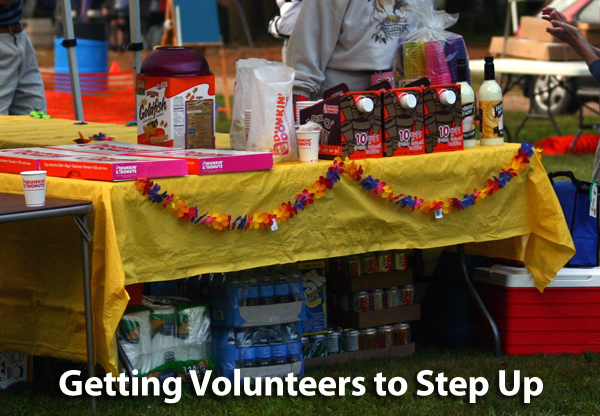By Jillian Rankin
The Ball Crawl
As a former recreation therapist I am constantly seeking out different and exciting ways to make worker incentives more fun! For our recent AKC indoor trial we added a “Sheltie Only Day” and offered all four classes. In addition to a Sheltie-themed worker raffle I came up with a new game to add to the mix. We called it the Sheltie Ball Crawl. I picked up 50 tennis balls and numbered each ball with a non-toxic black marker. I also took a small notebook and wrote the numbers 1-50 on each line. Anyone that worked at least one class during that day got to choose a number and write their name next to that number in the book, which was kept next to our awards table.
 The rest of the weekend was an all-breed trial. Since folks liked the game so much, we decided to offer it the rest of the weekend with great results! Folks did indeed stuck around to see the performance of the dog “drawing” the winning number and we did fill up all 50 spots in the book each day. The prize for the other two days was a custom-made decal of the winner’s choice from one of our vendors that cost us a mere $5 each. Saturday’s winner got theirs on Sunday. Sunday’s winner had hers mailed to her.
The rest of the weekend was an all-breed trial. Since folks liked the game so much, we decided to offer it the rest of the weekend with great results! Folks did indeed stuck around to see the performance of the dog “drawing” the winning number and we did fill up all 50 spots in the book each day. The prize for the other two days was a custom-made decal of the winner’s choice from one of our vendors that cost us a mere $5 each. Saturday’s winner got theirs on Sunday. Sunday’s winner had hers mailed to her.
- Consider adding few large-ticket items to your raffle. Club members who don’t have the time to go shopping for items or time to put together a basket may be willing to go in with a couple of club members to purchase one larger ticket item.
Jo Lesko’s club holds a trial in Dream Park in NJ, which is 1.5 hours from their home turf in Eatontown, NJ. A few years ago they introduced a Super Raffle that includes four items that are each valued at $50 for volunteers that work more than one class per day. They offer a regular worker raffle as well. Worker tickets can be used for the worker raffle or traded in for Super Raffle tickets. Items generally include things such as a $50 club gift certificate, plus items like chairs, shade tarp, custom-made gear bags, fancy dog beds, mats, crates, battery-operated fans, etc.
- Think outside the box! Lisa Barrett judged at a trial hosted by the Virginia Ruff Riders where they did something fun to jazz up their normal raffle. In addition to the usual worker lunches and raffles, they asked the workers to join up in teams at the beginning of each day. The team with the most worker tickets at the end of the day won a big fun gift basket to share. Teams came up with really fun names and the competition had folks fighting for jobs all weekend long!
- Remember, raffle prizes don’t always have to be agility or dog themed. Local business and online companies are great resources for raffle donations that don’t cost you a penny! Also if you’re cramped for space at your trial venue, gift certificates can easily be put into a binder for viewing. Seek out local restaurants, attractions, and pet-friendly hotels in the area to approach about donating gift certificates.
Make sure that you explain how much business gets brought to area because of your trial and how a donation that lets folks know about their business could potentially draw more folks to them for future trials. The best way to ask for these kinds of donations is in person, especially if you have a club member with a connection. Well thought-out donation request letters, sent in advance of the event and on club letterhead, can also be used to ask for donations. Always make sure you keep a list of donors and contacts to send a thank-you card to after the event that states how much their donation helped with the event.
- Make vendors work for you! If you have a venue that allows for enough space for vendors, take advantage of the opportunity. Our club allows vendors at our outdoor show and we ask for a donation to our worker raffle for each day that they are present. We get donations of all sorts of fun stuff from gift certificates for embroidery and massage to custom-made leashes and photos from our show photographer. Exhibitors get vendors to shop at, we get donations for the raffle, and the vendors hopefully make money for being there. It’s a win-win for everyone!
- Make sure that you think about time of year when setting out refreshments. If your trial is an outdoors in 105-degree weather, make sure you have plenty of water available. If your trial is indoors and the outdoor temperature is below 0 degrees, have a pot of something hot available all day instead of just in the morning, in addition to the water selection. It does make a huge difference!
- Don’t forget about folks that may have special diets. Several of our hardest workers are vegetarian. When I order pizza or subs for our workers, I always make sure that there is an option for them. Several of them have thanked me personally for doing so since they often have to bring their own food, even if they work at trials. I’ve also found that folks who are not vegetarian, but are looking to eat healthier, partake in those options as well so we rarely have leftovers of the vegetarian options.
 Make sure there is enough for all of your workers! There is nothing more disappointing then working a big class that happens to run into the time that the food comes and having nothing to choose from when you’re done working. Several suggestions to ensure that there is enough food for everyone include handing out vouchers for food vendors if there is one on site; or if you’re providing food, try splitting when the food is put out to ensure everyone gets some, and it’s fresh when they do so.
Make sure there is enough for all of your workers! There is nothing more disappointing then working a big class that happens to run into the time that the food comes and having nothing to choose from when you’re done working. Several suggestions to ensure that there is enough food for everyone include handing out vouchers for food vendors if there is one on site; or if you’re providing food, try splitting when the food is put out to ensure everyone gets some, and it’s fresh when they do so.
“worker pool” can make or break their impressions of volunteering at events, possibly for the lifetime of their involvement in the sport.
Jillian Rakin CPDT-KA has been actively competing dog sports for the past 19 years. She has acted as the special events coordinator for a large training facility in Farmington NY, as well as an agility trial chair for the Central NY Shetland Sheepdog Club and for the Dog Obedience Training Club of Rochester NY. She is currently running a 9 year old sheltie ("Dawn" U-CH Canami's Age of Aquarius RE CD AX AXJ NF CL1 CL2-F CL2-H CGC/TDI) and has her daughter ("Leia" Sorella's Rebel Princess) in training. Her sister Brieaynn Ellis and her share the kennel name "Sorella Shelties & Aussies" and are based out of the Rochester, NY area. They train and compete with their dogs in Obedience, Agility, Rally, Obedience, Conformation, Flyball, Herding, Therapy dog work, and Lure Coursing.




